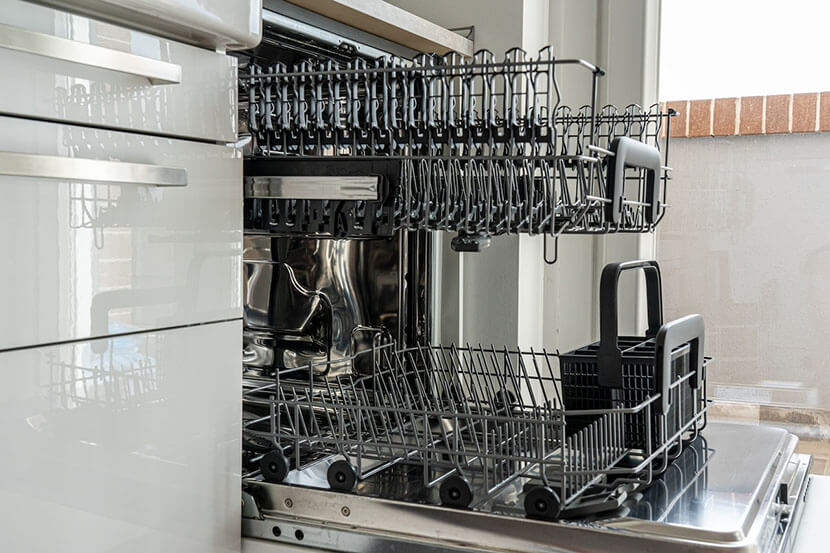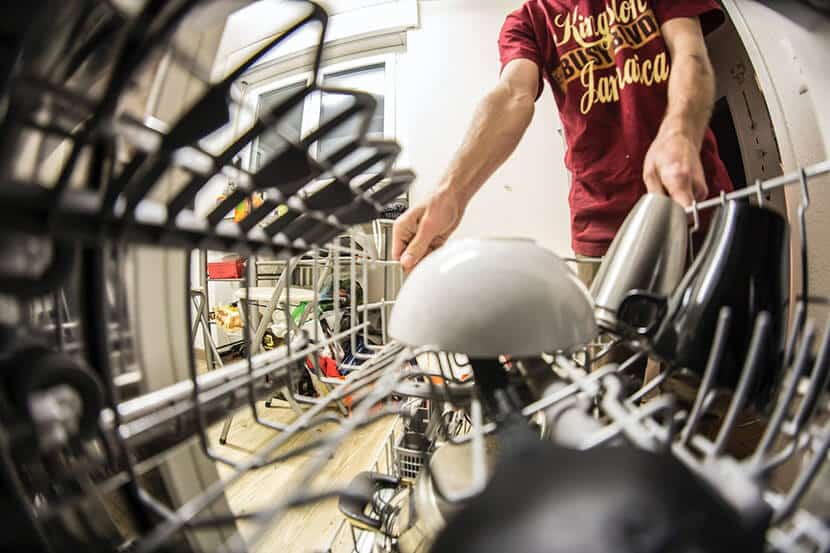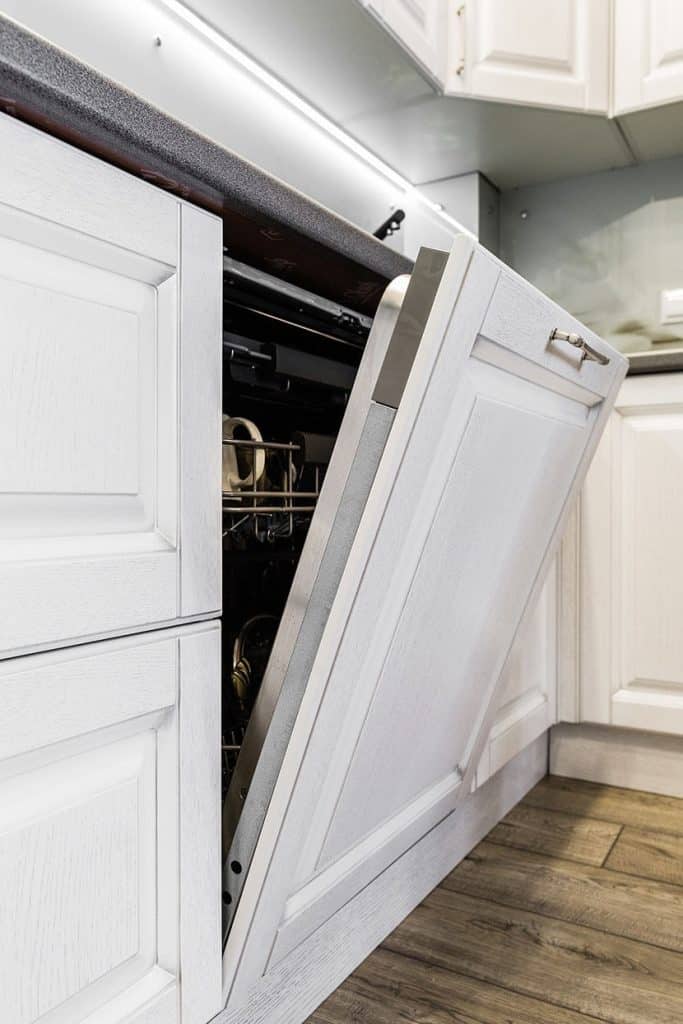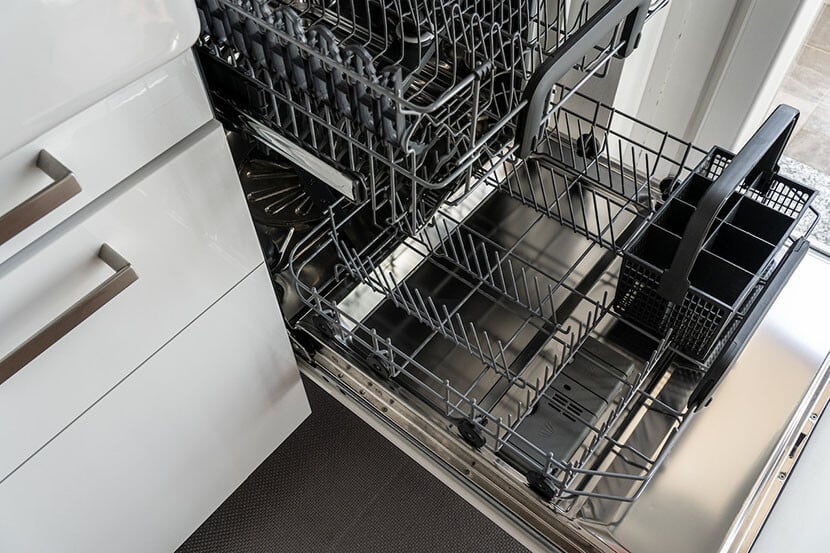
For anyone that has washed dishes by hand in the past, having a dishwasher to do the dirty work for you truly feels like a gift from the heavens! It saves time and energy that most of us never seem to have enough of anyway. Yet, somewhere along the way, we started to take the dishwasher for granted, and neglected maintaining it the way it ought to be. Unfortunately, the consequences of not taking care of a dishwasher is something many learn first hand.
Like any other household appliance, lack of cleaning and maintenance lowers the dishwasher’s performance and, even worse, leads to mechanical problems that potentially cause irreparable damage if not addressed early on. From food residue causing clogs in the pipes and spray arms, to grease, grime, and funky odors that create a highly unhygienic dishwasher interior, there are certainly plenty of valid reasons to clean your dishwasher in a timely manner! So, before we explain how to clean dishwasher components and the stainless steel interiors, let’s talk about when your dishwasher is due for a deep clean.
How to Identify Common Dishwasher Problems

While some signs are obvious, others can be pretty subtle. Therefore, it is important to pay close attention to even the slightest changes you notice while your dishwasher is running (or even when it’s idle).
Here is a brief look at a few problems that dishwashers encounter.
Leakages
Typically caused by a broken or damaged door seal, clogging or damage of the drainage hose, or defects in the pump gasket, a leaking dishwasher must be stopped and inspected immediately to address the problem.
Poor Cleaning Results
If your dishes aren’t being cleaned properly after a full wash cycle, this could indicate a reduced water pressure (usually a pump issue or blockage), issues with the electronic dishwasher control components, or a circuit problem.
Water Isn’t Draining Completely
Food particles clogging the drain pipe is quite common in dishwashers, however, if the water isn’t draining fully after a cycle, it could also mean that there is an issue with the drain pump.
Loud or Unusual Noises
A sudden change or loud sound in the dishwasher can be caused by various factors. Sometimes, it’s as simple as overloading the appliance, or something obstructing the spray arms while other times you might be dealing with a damaged pump, or other electrical issues.
Foul Odor
Decaying food debris is bound to cause a foul smell in dishwashers at some point. Therefore, if food remnants are not cleaned out from the strainer, or anywhere else they might be collecting, you will start to get a bad odor from the appliance.
How to Clean Dishwashers in Five Steps

While major problems or undetermined issues with a dishwasher should be handled by a professional, if your trusty appliance merely needs a clean, you can easily do this yourself. All you need are a few basic tools and materials, and a well explained step-by-step guide on how to do it! Fortunately, we’ve got all the information right here for you! Take a look.
What You’ll Need:
- Microfiber cloths
- Dish soap
- Baking soda
- White vinegar
- Scrubber
- Sponge
- Paper towels
- Toothbrush (or a soft bristle brush)
- Spray bottle
- Dishwasher safe bowl
IMPORTANT:
Before you clean a dishwasher, be sure to turn the appliance off and unplug it. You should also shut off the water supply to the appliance until you are required to run a cycle.
Step 1: Take Out Removable Parts and Clean Separately
Most dishwashers have a shallow top rack for cups, mugs, glasses, and smaller items, and a large bottom rack for plates and utensils. At the bottom of the appliance, you will find the dishwasher drain trap which is essentially a mesh strainer to catch food bits or large debris. Adjacent to this is the filter of your dishwasher.
With an empty dishwasher in front of you, begin by taking out the racks and cleaning them in your kitchen sink with dish soap, warm water, and a scrubber. If needed, you can soak them in a hot soapy solution for 10 minutes to loosen grime and hardened food or grease; then proceed to scrub the racks and rinse them off.
Located near the drain, you will see the top of the filter which simply needs to be twisted and lifted upward to remove. Thereafter, you should also be able to remove the mesh strainer and clean both components separately. Use a toothbrush to clean off food particles, and run water through the filter and strainer to unclog holes. Clean the components with dish detergent and a sponge before rinsing thoroughly. Allow them to air-dry on a rack.
If you have a removable detergent dispenser, soak it in warm water before cleaning it with a soft bristle brush and regular dish soap. Months of soap scum buildup in the detergent dispenser may require up to 15 minutes of soaking time for an efficient clean.
Step 2: Choose the Cleaning Product
When it comes to picking the right solution to clean your dishwasher, consider how dirty or grimy the interiors are. If you are dealing with a lot of buildup or stubborn stains, perhaps a commercial dishwasher cleaner is the better option. For maintenance or regular deep cleaning, we advise an all-natural cleaning combination consisting of distilled white vinegar and baking soda.
Remember, the idea behind dishwasher cleaning is not just about eliminating grime but sanitizing the inside, and neutralizing odors as well. With the ingredients mentioned above, there is no shortage of cleansing power, coupled with bacteria-fighting properties to help you achieve a desired cleaning result.
Step 3: Clean Inside the Dishwasher

When cleaning the interiors of a stainless steel dishwasher, it’s important to do it in a stepwise fashion so that nothing is overlooked. It also ensures that you aren’t doubling your work as you go. With that in mind, here is our systematic approach to cleaning inside the dishwasher:
- Using paper towels, wipe the inside of the filter chamber, as well as the drain and surrounding area below the strainer. Remove food scraps and debris during this step, and then move on to the next.
- In a spray bottle, combine equal parts white vinegar and water; shake the bottle well, and spray the solution onto a microfiber cloth. Use this to deep clean the filter chamber and drain before placing the components back.
- Turn your attention to the spray arms by inspecting the blades for grease, stains, or grime, as well as the water holes for clogs caused by debris and/or mineral deposits. Clean the spray arm with a toothbrush and your vinegar spray. If needed, use a toothpick to unclog the water holes before wiping the blades clean with paper towels.
- To self-clean the stainless steel interior, sprinkle 1 cup of baking soda over the bottom of the dishwasher, and then put the top rack and bottom rack back inside. Next, take a heat resistant bowl, pour in 1-2 cups of white vinegar, and place it in the middle of the top rack. Run a hot cycle and allow it to finish.
- After the cleaning cycle is complete, check the interior for any spots that might need manual scrubbing. Use a toothbrush or scrubber the clean areas that need attention.
- To clean the gasket that runs along the perimeter of the basin, use a clean cloth and raw vinegar. This component is prone to mold and mildew so it pays to take your time and be vigilant when cleaning the seal.
- Finish off by running another full hot water cycle to rinse off the interiors, and leave the door open for the inside to air out and dry once complete.
Step 4: Clean the Door Interior
With all that splashing going on inside the dishwasher, one can expect the interior of the door to get grimy and greasy overtime. Fortunately, the two handy ingredients we are using today will take care of that with no trouble.
Start by opening the dishwasher door open so that it is horizontal, sprinkle baking soda over it as evenly as possible (spread the powder around with your hand if needed), and then spray it with undiluted vinegar. This will cause a bubbling reaction that will begin the process of cutting through the grease and stains.
After a few minutes, take a clean, slightly damp cloth, and wipe the door to remove the cleaning agents. Finish off by wiping over the surface with paper towels to get rid of any moisture.
Step 5: Wipe Down the Exterior
Whether it’s grease from cooking, or dirty fingers that touch your dishwasher’s exterior, sooner or later, you can expect some amount of dirt and grime to find its way to the surface. So, if you’re cleaning the inside of the dishwasher, don’t forget the outside.
For this, use the vinegar-water solution by spraying a clean cloth to dampen it, then wipe the entire exterior including the door handle and control knobs/buttons. Finish off by opening the door and wiping the sides/edges of the dishwasher door. With that, the deep clean of your dishwasher is complete!
Quick Tips to Maintain Your Dishwasher

From cleaning hacks to expert advice that guarantee to keep your dishwasher clean, sanitary, smelling fresh, and running smoothly for years to come, we’ve got the tips you need to maintain your dishwasher. Take a look below!
Clean the Filter Regularly
At least once a month, take out the dishwasher filter, clean it thoroughly, and inspect the material for damage. Even the slightest defect in the filter can lead to serious problems in your dishwasher; therefore, it is important to replace the component as soon as you suspect damage or wear and tear.
Run a Vinegar Cycle for Routine Cleaning
As explained earlier, you can self-clean your dishwasher to break down grime, grease, and stuck on food bits by putting a bowl of white vinegar on the top rack (in an empty dishwasher), and running the hottest cycle. Thereafter, leave the door open and allow the inside to air-dry. As a natural deodorizer, vinegar can also help remove lingering odors.
Inspect the Spray Arms After a Few Cycles
The spray arms get clogged quite often, thereby reducing the water pressure which is vital for cleaning dirty dishes. Fortunately, all you need is a toothpick or a fine wire to unclog the holes, and you’re good to go.
Don’t Overload the Dishwasher
Dishwashers have varying capacities that factor in size, weight, and water levels. One must always refer to the user guide to ensure that the racks are not overloaded, and the dirty dishes are loaded correctly. Improper use of a dishwasher can lead to costly repairs, therefore, understanding your specific model is certainly worth the effort.
Wipe the Seal/Gasket Regularly
The last thing you want growing in your dishwasher is mold or mildew. This can be avoided by simply cleaning the rubber gasket once a month using vinegar and a clean microfiber cloth. In case you are dealing with fungus, hydrogen peroxide is a more effective cleaning agent for killing spores and bacteria.
Air Out the Dishwasher
Damp, humid environments contribute to mold growth, as well as unpleasant odors. Therefore, an empty dishwasher should be aired out, especially after a hot cycle. This allows the inside to dry and cool faster, thereby eliminating the aforementioned problems.
CONCLUSION
While you might think that cleaning a dishwasher is a job for the professionals, unless there is an underlying issue with the appliance, a DIY clean is a lot simpler than you would imagine! With a few basic cleaning tools and some vinegar and baking soda, cleaning the dishwasher is made easy with our step-by-step guide above. Everything from removing components to the cleaning techniques involved ensure a thorough deep clean which, in turn, aids in keeping up the dishwasher’s optimal performance. Additionally, a few simple maintenance tips like cleaning the filter regularly, and running a short cycle (on the hottest setting) with vinegar filled in a dishwasher safe cup every week or so will go a long way in maintaining a clean, fresh, and sanitary dishwasher!

